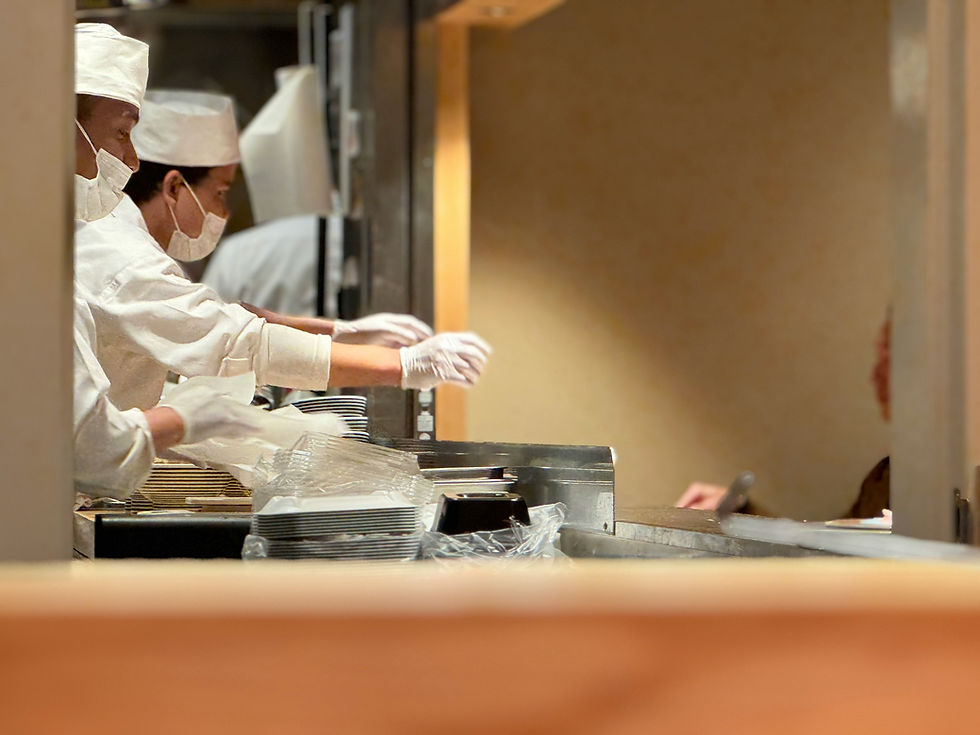Designing Deliciousness: Personalization and the Five Senses【#002】
- amika
- Jul 17
- 4 min read
Updated: Jul 31
Space, scent, memory, language—
The experience of flavor is crafted through all five senses.
It’s not just tasted. It’s designed.
In this edition, we sit down once again with sommelier Lawrence Nakamura
to explore how deliciousness can be delivered—
not only through technique, but through personalization.
What does it mean to create a taste that truly reaches someone?
Let’s find out.
An interview with Lawrence Nakamura
Exploring What It Means to Be Human—Through Taste
Interviewer:
___Lawrence, I’d love to start with a simple question:
When do people feel that something is delicious?
Lawrence:
That’s a great question—and actually a tough one.
If I’m being honest, the first thing I’d say is:
There’s no definitive answer. (laughs)
And that’s exactly what makes it fascinating.
The way we perceive taste differs from person to person, and even from moment to moment.
It’s that fluidity that makes deliciousness so compelling.
To me, taste isn’t just a sensory matter—it’s a doorway into understanding who we are.
If I were to put it dramatically: tasting is a kind of adventure.
Taste, scent, memory… as you follow those threads,
you might find yourself discovering something about yourself.
Asking, “What is taste?” becomes a way of asking, “What does it mean to be human?”
Deliciousness Is Designed
Lawrence:
Most people experience deliciousness as something they simply receive.
But for those of us who design taste experiences—from the creation side—the landscape looks completely different.
We ask ourselves:
How can we guide someone to feel deliciousness?
Things like:
What order are the flavors introduced in?
What kind of space are they experienced in?
These factors can completely change the impression—even if the drink or dish itself stays exactly the same.
When the Senses Are Blocked, Flavor Fades

Lawrence:
Let’s talk about what happens when the senses are diminished.
Think of a TV show where guests try to identify wines while blindfolded.
Their vision is blocked. They’re under studio lights, in a high-pressure environment.
They’re given just a spoonful of wine—barely enough to release any aroma.
And aroma is deeply linked to memory.
When someone’s nervous, their memories are harder to access.
So in that setting, even professionals struggle to identify the wine.
Even the fear of “getting it wrong” or the pressure to “be entertaining” dulls the senses.
That’s why those shows, while entertaining, also reveal something real:
how fragile and contextual our sense of taste truly is.
Interviewer:
__So on the flip side, if we can create an environment where the senses are more open,
can we also enhance the experience of deliciousness?
Lawrence:
Absolutely.
The key is designing the kind of space where the senses can come alive.
Taste Happens in Atmosphere and Air

Lawrence:
Imagine a clean, open kitchen.
You can see that care is being taken.
You feel that the space is hygienic, thoughtful.
That alone can change how something tastes—even before the first bite.
On the flip side, a cluttered or dirty kitchen can make you hesitant.
That doubt alters your perception before you even taste the food.
Then there’s the live atmosphere—watching food being prepared in real time.
That sense of presence, of being served with intention, builds anticipation.
In the end, deliciousness isn’t just about taste.
It’s a total experience: space, air, human interaction, feeling.
Memory, Made Personal
Interviewer:
When you design how to “deliver” deliciousness—what else do you consider?
Lawrence:
One word: personalization.
You have to adapt to the person in front of you.
For instance, when I describe a natural wine to Japanese guests,
I might say, “It has a note of dokudami,”—a herb with a very distinct aroma.
That works in Japan, where people know what dokudami smells like.
But if I say that to someone overseas, they’ll be lost.
They’ve never smelled it.
Interviewer:
—so even flavor language is shaped by culture.
Lawrence:
Exactly.
Understanding someone’s cultural background, food history, and personal associations is the first step in helping them receive flavor.
Yes, we also need shared, general language to communicate taste.
But at the same time, we must ask:
What resonates with this person?
Ultimately, deliciousness is about unlocking someone’s personal drawer of memories.
The more precisely and gently we do that, the more deeply they can taste.
More Info ≠ More Delicious
Lawrence:
And here’s something that’s often overlooked—the amount of information we give.
If a sommelier offers a highly detailed explanation,
it can overwhelm the guest.
They might think, “I don’t sense all that… Maybe I’m missing something.”
More information isn’t always better.
Sometimes, editing it down is also part of the design.
Deliciousness isn’t about giving someone a lecture.
It’s about helping them have a moment of pleasure.
And to do that, we sometimes need to leave a little space.
A moment to simply feel, not analyze.
✏️ Editor’s Note
In this edition, we explored the question:
What does it mean to “deliver” deliciousness?
Who is it for?
What kind of experience do we want them to have?
And how do we design for that—both sensorially and personally?
Revisiting these questions with Lawrence was a powerful reminder:
Deliciousness isn’t just about what’s on the plate.
It’s about intention, context, and care.
And perhaps, it’s also an invitation to see flavor as a kind of dialogue.
Next time, we’ll ask:
Does aroma determine taste?
We’ll unravel the relationship between smell and flavor—and how the senses work together to shape what we perceive.
Stay tuned.
Yoshihito “Lawrence” Nakamura
Certified Sake Sommelier / Wine Sommelier
With deep expertise in both sake and wine, Lawrence has been involved in launching restaurants, curating beverage programs, and advising food and drink brands. He joined the Apoptosis team in 2024.
His work has been recognized with numerous awards, including
“Best Sake List in Japan” and “Most Original Wine List in Asia.”
Apoptosis also regularly hosts tasting events for non-alcoholic beverages,especially for professionals in the food and beverage industry.For more details, please visit the page linked below.



